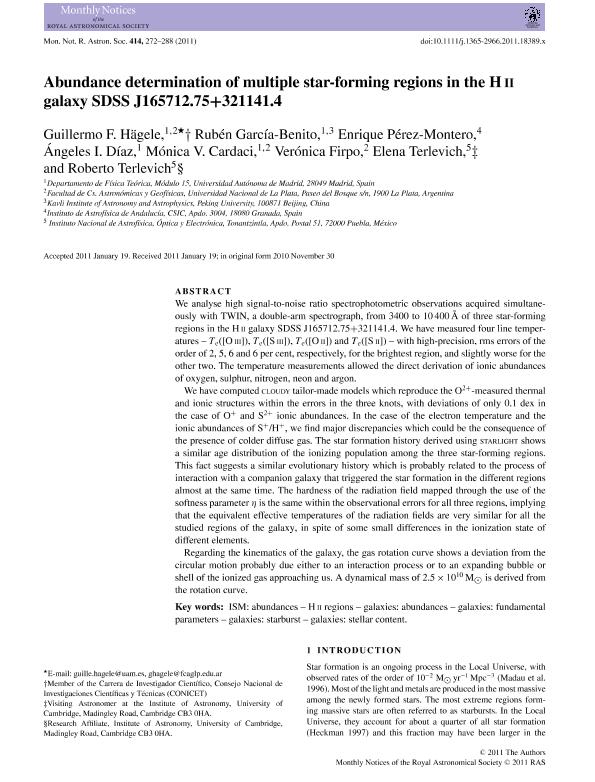Artículo
Abundance determination of multiple star-forming regions in the HII galaxy SDSS J165712.75+321141.4
Hägele, Guillermo Federico ; García Benito, Rubén; Pérez Montero, Enrique; Díaz, Ángeles I.; Cardaci, Monica Viviana
; García Benito, Rubén; Pérez Montero, Enrique; Díaz, Ángeles I.; Cardaci, Monica Viviana ; Firpo, Verónica; Terlevich, Elena; Terlevich, Roberto
; Firpo, Verónica; Terlevich, Elena; Terlevich, Roberto
 ; García Benito, Rubén; Pérez Montero, Enrique; Díaz, Ángeles I.; Cardaci, Monica Viviana
; García Benito, Rubén; Pérez Montero, Enrique; Díaz, Ángeles I.; Cardaci, Monica Viviana ; Firpo, Verónica; Terlevich, Elena; Terlevich, Roberto
; Firpo, Verónica; Terlevich, Elena; Terlevich, Roberto
Fecha de publicación:
01/2011
Editorial:
Wiley Blackwell Publishing, Inc
Revista:
Monthly Notices of the Royal Astronomical Society
ISSN:
0035-8711
Idioma:
Inglés
Tipo de recurso:
Artículo publicado
Clasificación temática:
Resumen
We analyse high signal-to-noise ratio spectrophotometric observations acquired simultaneously with TWIN, a double-arm spectrograph, from 3400 to 10 400Å of three star-forming regions in the HII galaxy SDSS J165712.75+321141.4. We have measured four line temperatures ?Te([O III]), Te([S III]), Te([O II]) and Te([S II])? with high-precision, rms errors of the order of 2, 5, 6 and 6 per cent, respectively, for the brightest region, and slightly worse for the other two. The temperature measurements allowed the direct derivation of ionic abundances of oxygen, sulphur, nitrogen, neon and argon. We have computed CLOUDY tailor-made models which reproduce the O2+-measured thermal and ionic structures within the errors in the three knots, with deviations of only 0.1 dex in the case of O+ and S2+ ionic abundances. In the case of the electron temperature and the ionic abundances of S+/H+, we find major discrepancies which could be the consequence of the presence of colder diffuse gas. The star formation history derived using STARLIGHT shows a similar age distribution of the ionizing population among the three star-forming regions. This fact suggests a similar evolutionary history which is probably related to the process of interaction with a companion galaxy that triggered the star formation in the different regions almost at the same time. The hardness of the radiation field mapped through the use of the softness parameter η is the same within the observational errors for all three regions, implying that the equivalent effective temperatures of the radiation fields are very similar for all the studied regions of the galaxy, in spite of some small differences in the ionization state of different elements. Regarding the kinematics of the galaxy, the gas rotation curve shows a deviation from the circular motion probably due either to an interaction process or to an expanding bubble or shell of the ionized gas approaching us. A dynamical mass of 2.5×10^10Msun is derived from the rotation curve.
Archivos asociados
Licencia
Identificadores
Colecciones
Articulos(IALP)
Articulos de INST.DE ASTROFISICA LA PLATA
Articulos de INST.DE ASTROFISICA LA PLATA
Citación
Hägele, Guillermo Federico; García Benito, Rubén; Pérez Montero, Enrique; Díaz, Ángeles I. ; Cardaci, Monica Viviana; et al.; Abundance determination of multiple star-forming regions in the HII galaxy SDSS J165712.75+321141.4; Wiley Blackwell Publishing, Inc; Monthly Notices of the Royal Astronomical Society; 414; 1; 1-2011; 1-17
Compartir
Altmétricas
Items relacionados
Mostrando titulos relacionados por título, autor y tema.
-
Artículo New quantitative nitrogen abundance estimations in a sample of Seyfert 2 active galactic nucleiDors Jr., O. L.; Arellano Córdova, K. Z.; Cardaci, Monica Viviana ; Hägele, Guillermo Federico (Wiley Blackwell Publishing, Inc, 2017-06)
-
Dors, Oli L.; Agarwal, B.; Hägele, Guillermo Federico ; Cardaci, Monica Viviana ; Rydberg, Claes Erik; Riffel, R. A.; Oliveira, A. S.; Krabbe, A. C. (Wiley Blackwell Publishing, Inc, 2018-09)
-
Carvalho, S.P.; Dors, O. L.; Cardaci, Monica Viviana ; Hägele, Guillermo Federico ; Krabbe, Nora Cristina; Pérez Montero, E.; Monteiro, A.F.; Armah, M.; Freitas Lemes, P. (Wiley Blackwell Publishing, Inc, 2020-06)



